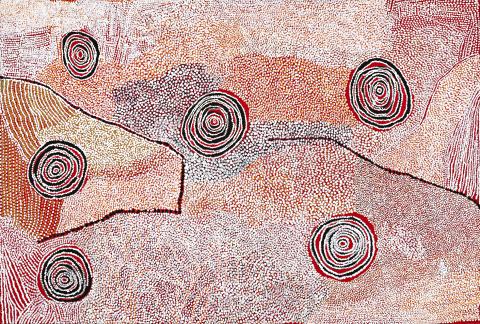ROCKHOLES NEAR THE OLGAS, 2008
BILL WHISKEY TJAPALTJARRI
synthetic polymer paint on linen
182.5 x 270.5 cm
bears inscription verso: Artist’s name, title, size and Watiyawanu Artists of Amunturrungu cat. 77-08457
Watiyawanu Artists of Amunturrungu, Mount Liebig
Private collection, Melbourne
It would be all too easy to misinterpret Bill Whiskey Tjapaltjarri's nickname. It stems in fact, not from any form of liquid, but rather is short for the very apt and affectionate nickname, 'Whiskery' - originally bestowed on the artist as a result of his startlingly ferocious beard.
As well as being a famed artist, Tjapaltjarri was Ngangkari (traditional healer) within his community and people travelled from throughout the region to seek his counsel and wisdom. A Pitjantjatjara artist, he was born in 1920 at Pirupa Akla, near the Olgas and west of Ayers Rock. As a youth, he joined many of his kin who had begun the move towards Haasts Bluff mission, about 250 kilometers away. However, many feared that the white-skinned people at the mission were Marnu (bad spirits) and Tjapaltjarri kept travelling before eventually settling at Armunturrungu (Mount Leibig), 100km North-West of Haasts Bluff.
Tjapaltjarri painted Rock Holes and Country Near the Olgas, 2008 in the last year of his life. It is a classic example of the style practiced by many of the Pitjantjatjara artists and features a typical motif of the lanscape portrayed from the air. And it is this unusual viewpoint, rarely employed by Western artists, that makes Tjapaltjarri works so unique. It is a landscape he clearly knew intimately, with every ridge, rock hole and pathway captured in mesmerising detail.
Although Tjapaltjarri only began painting in 2004, four years before his death, his works, primarily depicting rockholes near Pirupa and his journey to Haasts Bluff, have become amongst the most sought-after Aboriginal art of his generation throughout Australia and internationally.
Tjapaltjarri was a two-time finalist in the Telstra Awards; his art has been exhibited internationally in Copenhagen, Singapore and London; and today, works by Tjapaltjarii may be found in several major public and private collections including the Kerry Stokes Collection WA, the Reg Grundy Collection, and the Art Gallery of South Australia.
ASHLEY CRAWFORD
